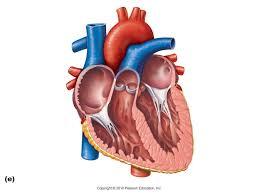The Cardiovascular System (CVS)

Explore the structure and functions of the Cardiovascular System (CVS) through this focused quiz. Assess your knowledge on heart anatomy, its layers, and blood supply mechanisms. Ideal for students and professionals in medical and health sciences.
- 1.
Write a few sentences on how the heart can generate its own action potentials. Ensure you include the pacemakers.
- 2.
Which is NOT a function of the cardiovascular system (CVS)?
- A.
Generating blood pressure
- B.
Separating pulmonary & systemic circulation
- C.
Regulating blood plasma volume
- D.
Provides nutrients to the body in the form of O2
Correct Answer
C. Regulating blood plasma volumeExplanation
The volume of blood plasma is controlled by the renal systemRate this question:
-
- 3.
The heart is located in the mediastinum
- A.
True
- B.
False
Correct Answer
A. TrueExplanation
The heart is located in the mediastinum, which is the central compartment of the thoracic cavity. It is bounded by the sternum in front, the vertebral column at the back, and the lungs on either side. The heart is positioned slightly to the left side of the mediastinum, and it is surrounded and protected by the pericardium. The mediastinum also contains other vital structures such as the great vessels, esophagus, and trachea. Therefore, the statement that the heart is located in the mediastinum is true.Rate this question:
-
- 4.
What is fibrous pericardium?
- A.
A thin layer surrounding the heart
- B.
A thick inner layer of membrane protecting the heart
- C.
A thick outer layer of membrane surrounding the heart
- D.
A continuous membrane covering the heart and stops expansion
Correct Answer
C. A thick outer layer of membrane surrounding the heartExplanation
The fibrous pericardium refers to the thick outer layer of membrane that surrounds the heart. This layer provides protection and support to the heart, helping to maintain its shape and integrity. It is composed of tough, fibrous connective tissue that helps to prevent overstretching of the heart during contractions and movements.Rate this question:
-
- 5.
The heart has 3 layers of tissue:1) Epicardium: outer surface2) Myocardium: middle muscular layer &3)?
Correct Answer
EndocardiumExplanation
The correct answer is "Endocardium." The endocardium is the innermost layer of tissue in the heart. It lines the chambers of the heart and covers the heart valves. This layer is made up of a thin layer of endothelial cells and connective tissue. The endocardium helps to prevent blood clots and provides a smooth surface for blood flow within the heart.Rate this question:
- 6.
The heart has its own blood supply and doesn't need the blood traveling in its atria and ventricles?
- A.
True
- B.
False
Correct Answer
A. TrueExplanation
The heart is nourished by blood from its coronary arteriesRate this question:
-
- 7.
Capillaries transport substances to and from cells. Select the substances below which are transferred in capillary exchange:
- A.
O2
- B.
Hormones
- C.
Nutrients
- D.
Wastes
Correct Answer(s)
A. O2
B. Hormones
C. Nutrients
D. WastesExplanation
Capillaries are tiny blood vessels that connect arteries and veins. They play a crucial role in the exchange of substances between the blood and the surrounding cells. Oxygen (O2) is transported from the lungs to the cells through capillaries, while waste products are carried away from the cells to be eliminated. Additionally, capillaries also transport hormones, which are chemical messengers that regulate various bodily functions. Lastly, nutrients, such as glucose and amino acids, are delivered to the cells through capillaries to provide energy and support cellular processes.Rate this question:
-
- 8.
Which is NOT a function of blood?
- A.
Transport of nutrients, gases and wastes
- B.
Regulation of pH
- C.
Maintainence of body temperature
- D.
Forms anitibodies to protect the body from disease
Correct Answer
D. Forms anitibodies to protect the body from diseaseExplanation
antibodies are formed only by certain white blood cells found in blood not the whole blood itself but we will revisit this in a coming compendiumRate this question:
-
Quiz Review Timeline +
Our quizzes are rigorously reviewed, monitored and continuously updated by our expert board to maintain accuracy, relevance, and timeliness.
-
Current Version
-
Mar 22, 2023Quiz Edited by
ProProfs Editorial Team -
Apr 17, 2016Quiz Created by
Adilah17feb
 Back to top
Back to top



